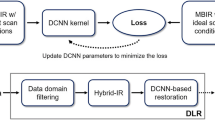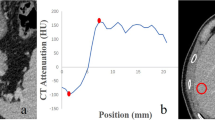Abstract
Background
CT image reconstruction has evolved from filtered back projection to hybrid- and model-based iterative reconstruction. Deep learning-based image reconstruction is a relatively new technique that uses deep convolutional neural networks to improve image quality.
Objective
To evaluate and compare 1.25 mm thin-section abdominal CT images reconstructed with deep learning image reconstruction (DLIR) with 5 mm thick images reconstructed with adaptive statistical iterative reconstruction (ASIR-V).
Methods
This retrospective study included 52 patients (31 F; 56.9±16.9 years) who underwent abdominal CT scans between August-October 2019. Image reconstruction was performed to generate 5 mm images at 40% ASIR-V and 1.25 mm DLIR images at three strengths (low [DLIR-L], medium [DLIR-M], and high [DLIR-H]). Qualitative assessment was performed to determine image noise, contrast, visibility of small structures, sharpness, and artifact based on a 5-point-scale. Image preference determination was based on a 3-point-scale. Quantitative assessment included measurement of attenuation, image noise, and contrast-to-noise ratios (CNR).
Results
Thin-section images reconstructed with DLIR-M and DLIR-H yielded better image quality scores than 5 mm ASIR-V reconstructed images. Mean qualitative scores of DLIR-H for noise (1.77 ± 0.71), contrast (1.6 ± 0.68), small structure visibility (1.42 ± 0.66), sharpness (1.34 ± 0.55), and image preference (1.11 ± 0.34) were the best (p<0.05). DLIR-M yielded intermediate scores. All DLIR reconstructions showed superior ratings for artifacts compared to ASIR-V (p<0.05), whereas each DLIR group performed comparably (p>0.05, 0.405-0.763). In the quantitative assessment, there were no significant differences in attenuation values between all reconstructions (p>0.05). However, DLIR-H demonstrated the lowest noise (9.17 ± 3.11) and the highest CNR (CNRliver = 26.88 ± 6.54 and CNRportal vein = 7.92 ± 3.85) (all p<0.001).
Conclusion
DLIR allows generation of thin-section (1.25 mm) abdominal CT images, which provide improved image quality with higher inter-reader agreement compared to 5 mm thick images reconstructed with ASIR-V.
Clinical Impact
Improved image quality of thin-section CT images reconstructed with DLIR has several benefits in clinical practice, such as improved diagnostic performance without radiation dose penalties.
Graphical Abstract




Similar content being viewed by others
References
Patino M, Fuentes JM, Singh S, Hahn PF, Sahani DV. Iterative Reconstruction Techniques in Abdominopelvic CT: Technical Concepts and Clinical Implementation. AJR Am J Roentgenol. 2015 Jul;205(1):W19-31. https://doi.org/10.2214/AJR.14.13402.
Kuo Y, Lin YY, Lee RC, Lin CJ, Chiou YY, Guo WY. Comparison of image quality from filtered back projection, statistical iterative reconstruction, and model-based iterative reconstruction algorithms in abdominal computed tomography. Medicine (Baltimore). 2016;95(31):e4456. https://doi.org/10.1097/MD.0000000000004456
Hara AK, Paden RG, Silva AC, Kujak JL, Lawder HJ, Pavlicek W. Iterative reconstruction technique for reducing body radiation dose at CT: feasibility study. AJR Am J Roentgenol. 2009;193(3):764-771. https://doi.org/10.2214/AJR.09.2397
Silva AC, Lawder HJ, Hara A, Kujak J, Pavlicek W. Innovations in CT dose reduction strategy: application of the adaptive statistical iterative reconstruction algorithm. AJR Am J Roentgenol. 2010;194(1):191-199. https://doi.org/10.2214/AJR.09.2953
Marin D, Nelson RC, Schindera ST, et al. Low-tube-voltage, high-tube-current multidetector abdominal CT: improved image quality and decreased radiation dose with adaptive statistical iterative reconstruction algorithm--initial clinical experience. Radiology. 2010;254(1):145-153. https://doi.org/10.1148/radiol.09090094
Han WK, Na JC, Park SY. Low-dose CT angiography using ASiR-V for potential living renal donors: a prospective analysis of image quality and diagnostic accuracy. Eur Radiol. 2020;30(2):798-805. https://doi.org/10.1007/s00330-019-06423-1
Yue M, Melnyk R. Benefits of ASiR-V * Reconstruction for Reducing Patient Radiation Dose and Preserving Diagnostic Quality in CT Exams. Published 2014. Accessed July 18, 2022. https://www.semanticscholar.org/paper/Benefits-of-ASiR-V-*-Reconstruction-for-Reducing-in-Yue-Melnyk/185b858e5de4d555d22b42544a6978065494401f
Lim K, Kwon H, Cho J, et al. Initial phantom study comparing image quality in computed tomography using adaptive statistical iterative reconstruction and new adaptive statistical iterative reconstruction v. J Comput Assist Tomogr. 2015;39(3):443-448. https://doi.org/10.1097/RCT.0000000000000216
Minamishima K, Sugisawa K, Yamada Y, Jinzaki M. Quantitative and qualitative evaluation of hybrid iterative reconstruction, with and without noise power spectrum models: A phantom study. J Appl Clin Med Phys. 2018;19(3):318-325. https://doi.org/10.1002/acm2.12304
Millon D, Vlassenbroek A, Van Maanen AG, Cambier SE, Coche EE. Low contrast detectability and spatial resolution with model-based Iterative reconstructions of MDCT images: a phantom and cadaveric study. Eur Radiol. 2017;27(3):927-937. https://doi.org/10.1007/s00330-016-4444-x
Euler A, Stieltjes B, Szucs-Farkas Z, et al. Impact of model-based iterative reconstruction on low-contrast lesion detection and image quality in abdominal CT: a 12-reader-based comparative phantom study with filtered back projection at different tube voltages. Eur Radiol. 2017;27(12):5252-5259. https://doi.org/10.1007/s00330-017-4825-9
Nishizawa M, Tanaka H, Watanabe Y, Kunitomi Y, Tsukabe A, Tomiyama N. Model-based iterative reconstruction for detection of subtle hypoattenuation in early cerebral infarction: a phantom study. Jpn J Radiol. 2015;33(1):26-32. https://doi.org/10.1007/s11604-014-0376-z
Chen G, Hong X, Ding Q, et al. AirNet: Fused analytical and iterative reconstruction with deep neural network regularization for sparse-data CT. Med Phys. 2020;47(7):2916-2930. https://doi.org/10.1002/mp.14170
Shin YJ, Chang W, Ye JC, et al. Low-Dose Abdominal CT Using a Deep Learning-Based Denoising Algorithm: A Comparison with CT Reconstructed with Filtered Back Projection or Iterative Reconstruction Algorithm. Korean J Radiol. 2020;21(3):356-364. https://doi.org/10.3348/kjr.2019.0413
Parakh A, Cao J, Pierce TT, Blake MA, Savage CA, Kambadakone AR. Sinogram-based deep learning image reconstruction technique in abdominal CT: image quality considerations. Eur Radiol. 2021;31(11):8342-8353. https://doi.org/10.1007/s00330-021-07952-4
Tamm EP, Rong XJ, Cody DD, Ernst RD, Fitzgerald NE, Kundra V. Quality initiatives: CT radiation dose reduction: how to implement change without sacrificing diagnostic quality. Radiogr Rev Publ Radiol Soc N Am Inc. 2011;31(7):1823-1832. https://doi.org/10.1148/rg.317115027
Nakaura T, Iyama Y, Kidoh M, et al. Comparison of iterative model, hybrid iterative, and filtered back projection reconstruction techniques in low-dose brain CT: impact of thin-slice imaging. Neuroradiology. 2016;58(3):245-251. https://doi.org/10.1007/s00234-015-1631-4
Sprawls P. AAPM tutorial. CT image detail and noise. Radiogr Rev Publ Radiol Soc N Am Inc. 1992;12(5):1041-1046. https://doi.org/10.1148/radiographics.12.5.1529128
Christianson O, Winslow J, Frush DP, Samei E. Automated Technique to Measure Noise in Clinical CT Examinations. AJR Am J Roentgenol. 2015;205(1):W93-99. https://doi.org/10.2214/AJR.14.13613
Funama Y, Awai K, Miyazaki O, et al. Improvement of low-contrast detectability in low-dose hepatic multidetector computed tomography using a novel adaptive filter: evaluation with a computer-simulated liver including tumors. Invest Radiol. 2006;41(1):1-7. https://doi.org/10.1097/01.rli.0000188026.20172.5d
Benson AB, Abrams TA, Ben-Josef E, et al. NCCN clinical practice guidelines in oncology: hepatobiliary cancers. J Natl Compr Cancer Netw JNCCN. 2009;7(4):350-391. https://doi.org/10.6004/jnccn.2009.0027
Tempero MA, Malafa MP, Al-Hawary M, et al. Pancreatic Adenocarcinoma, Version 2.2021, NCCN Clinical Practice Guidelines in Oncology. J Natl Compr Cancer Netw JNCCN. 2021;19(4):439-457. https://doi.org/10.6004/jnccn.2021.0017
Soo G, Lau KK, Yik T, Kutschera P. Optimal reconstructed section thickness for the detection of liver lesions with multidetector CT. Clin Radiol. 2010;65(3):193-197. https://doi.org/10.1016/j.crad.2009.10.009
Leonardi M, Bongartz G, Geleijns DJ, et al. (1999) European guidelines on quality criteria for computed tomography. European Commission. http://www.drs.dk/guidelines/ct/quality/htmlindex.htm. Accessed 18 June 2020.
National Research Council. Health Risks from Exposure to Low Levels of Ionizing Radiation: BEIR VII Phase 2. The National Academies Press; 2006. https://doi.org/10.17226/11340
Jensen CT, Liu X, Tamm EP, et al. Image Quality Assessment of Abdominal CT by Use of New Deep Learning Image Reconstruction: Initial Experience. AJR Am J Roentgenol. 2020;215(1):50-57. https://doi.org/10.2214/AJR.19.22332
Akagi M, Nakamura Y, Higaki T, et al. Deep learning reconstruction improves image quality of abdominal ultra-high-resolution CT. Eur Radiol. 2019;29(11):6163-6171. https://doi.org/10.1007/s00330-019-06170-3
Cao L, Liu X, Li J, et al. A study of using a deep learning image reconstruction to improve the image quality of extremely low-dose contrast-enhanced abdominal CT for patients with hepatic lesions. Br J Radiol. 2021;94(1118):20201086. https://doi.org/10.1259/bjr.20201086
von Falck C, Galanski M, Shin HO. Informatics in radiology: sliding-thin-slab averaging for improved depiction of low-contrast lesions with radiation dose savings at thin-section CT. Radiogr Rev Publ Radiol Soc N Am Inc. 2010;30(2):317-326. https://doi.org/10.1148/rg.302096007
Szczykutowicz TP, Nett B, Cherkezyan L, et al. Protocol Optimization Considerations for Implementing Deep Learning CT Reconstruction. AJR Am J Roentgenol. 2021;216(6):1668-1677. https://doi.org/10.2214/AJR.20.23397
Tamura A, Nakayama M, Ota Y, et al. Feasibility of thin-slice abdominal CT in overweight patients using a vendor neutral image-based denoising algorithm: Assessment of image noise, contrast, and quality. PloS One. 2019;14(12):e0226521. https://doi.org/10.1371/journal.pone.0226521
Bushberg JT, Seibert JA, Leidholdt EM, Boone JM. The Essential Physics of Medical Imaging. Fourth edition. Wolters Kluwer Health; 2020.
Abdelmoumene A, Chevallier P, Chalaron M, et al. Detection of liver metastases under 2 cm: comparison of different acquisition protocols in four row multidetector-CT (MDCT). Eur Radiol. 2005;15(9):1881-1887. https://doi.org/10.1007/s00330-005-2741-x
De Marco P, Origgi D. New adaptive statistical iterative reconstruction ASiR-V: Assessment of noise performance in comparison to ASiR. J Appl Clin Med Phys. 2018;19(2):275-286. https://doi.org/10.1002/acm2.12253
Euler A, Solomon J, Marin D, Nelson RC, Samei E. A Third-Generation Adaptive Statistical Iterative Reconstruction Technique: Phantom Study of Image Noise, Spatial Resolution, Lesion Detectability, and Dose Reduction Potential. AJR Am J Roentgenol. 2018;210(6):1301-1308. https://doi.org/10.2214/AJR.17.19102
Funding
This study was funded by GE (Grant number 237908 to Avinash Kambadakone).
Author information
Authors and Affiliations
Corresponding author
Ethics declarations
Conflict of interest
Avinash Kambadakone: Research grants (GE, Philips Healthcare and PanCAN). Simon Lennartz: Research support (Philips Healthcare).
Additional information
Publisher's Note
Springer Nature remains neutral with regard to jurisdictional claims in published maps and institutional affiliations.
Rights and permissions
Springer Nature or its licensor (e.g. a society or other partner) holds exclusive rights to this article under a publishing agreement with the author(s) or other rightsholder(s); author self-archiving of the accepted manuscript version of this article is solely governed by the terms of such publishing agreement and applicable law.
About this article
Cite this article
Cao, J., Mroueh, N., Pisuchpen, N. et al. Can 1.25 mm thin-section images generated with Deep Learning Image Reconstruction technique replace standard-of-care 5 mm images in abdominal CT?. Abdom Radiol 48, 3253–3264 (2023). https://doi.org/10.1007/s00261-023-03992-0
Received:
Revised:
Accepted:
Published:
Issue Date:
DOI: https://doi.org/10.1007/s00261-023-03992-0




